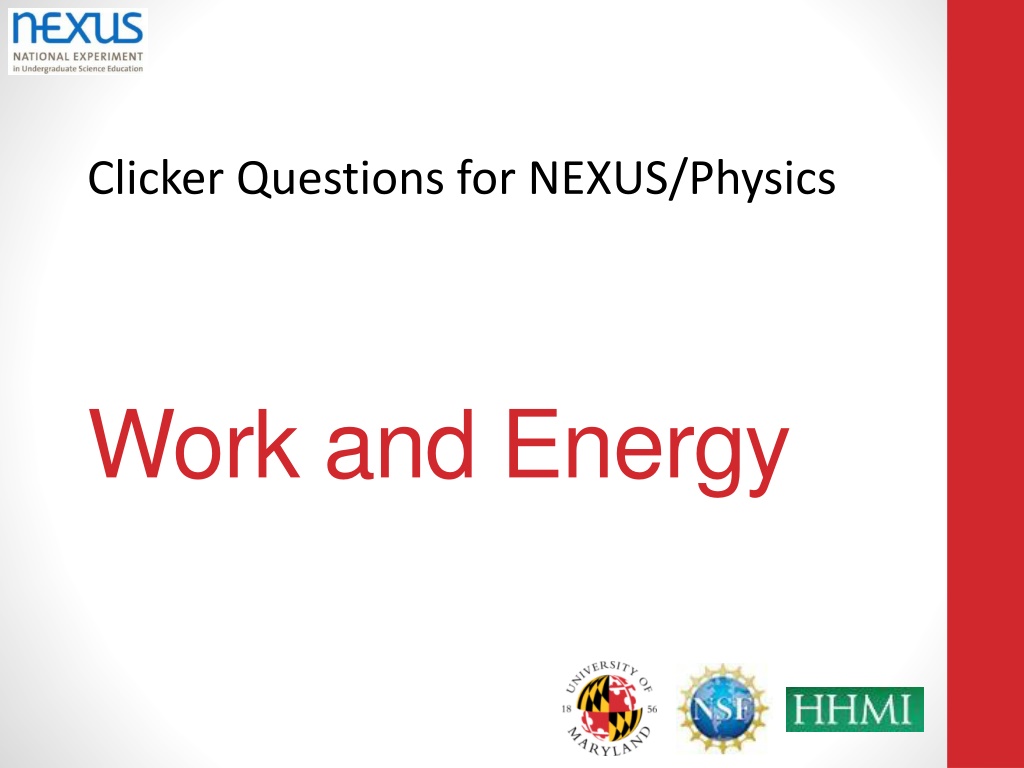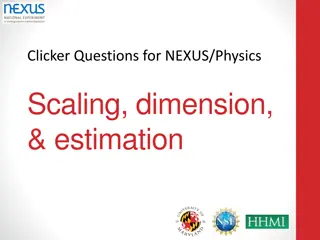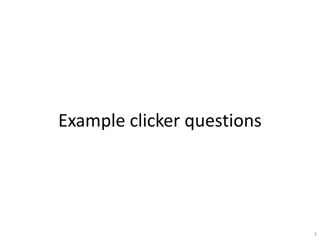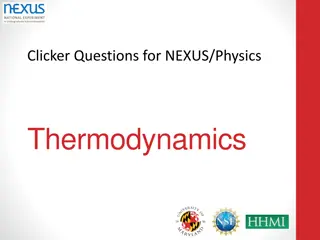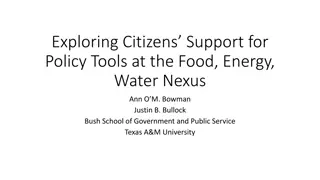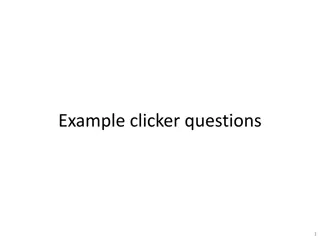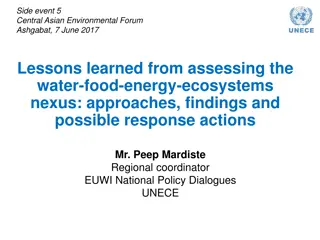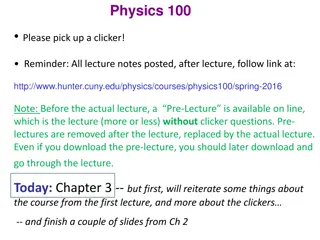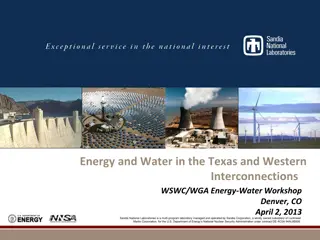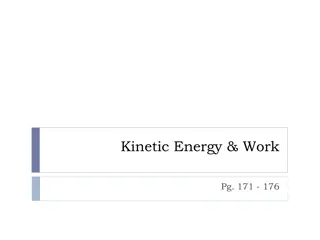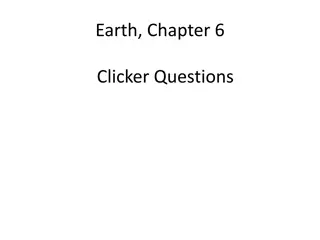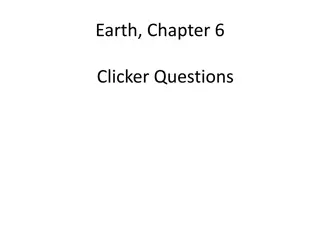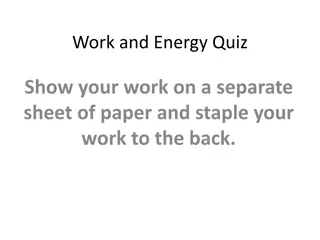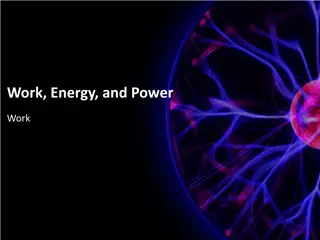Clicker Questions for NEXUS: Physics Work and Energy
This booklet provides clicker slides to encourage class discussion and develop students' understanding of scientific thinking. The usage emphasizes the importance of probing students' thinking through mistakes and encouraging interactions among students for enhanced learning.
Download Presentation

Please find below an Image/Link to download the presentation.
The content on the website is provided AS IS for your information and personal use only. It may not be sold, licensed, or shared on other websites without obtaining consent from the author. Download presentation by click this link. If you encounter any issues during the download, it is possible that the publisher has removed the file from their server.
E N D
Presentation Transcript
Clicker Questions for NEXUS/Physics Work and Energy
A note on usage: The clicker slides in this booklet are meant to be used as stimuli to encourage class discussion. They are intended for use in a class that attempts to help students develop a coherent and sophisticated understanding of scientific thinking. They are NOT intended as items to test whether students are right or wrong or know the correct answer by one-step recall if enough cues are given. This has a number of instructional implications that are reviewed in general on the next four slides. The individual slides also contain annotations discussing their intended use.
Usage: 1 Feedback One of the most important values of a clicker- response system is to provide instructors with some understanding of what students are thinking. Good clicker questions can be highly revealing (and surprising). But the critical fact is not that the students make mistakes but to use those mistakes to probe their thinking and find out why. This raises the importance of a rich subsequent discussion well above letting the students know what the right answer is.
Usage 2: Student-student interactions The critical value for student learning occurs in what happens after a clicker question has obtained a mixed response from the students. The standard next cue is, Find someone who disagreed with the answer you chose and see if you can convince them. After a minute or two of discussion, a second click may show students having moved dramatically towards the correct answer. A brief call for who changed their answer and why can lead to a useful exchange. When they have not moved significantly, more discussion is called for.
Usage: 3 Incompletely specified questions Some items have questions that are simple if idealized assumptions are made, subtler if they are not. Part of the discussion of these items are intended to include issues of modeling, idealizations, and hidden assumptions. Questions where answers are not provided. In these items, the intent is to have students come up with potential answers and have the instructor collect them and write them on the board. Occasionally, especially at the beginning of a class, it may take some time before students are willing to contribute answers. It can help if you have some prepared answers ready, walk around the class, and put up the answers as if they came from the students. This can help students get more comfortable with contributing.
Usage: 4 Cluster questions Some questions are meant to be used as part of a group of questions. In this case, resolving the answers to individual questions is better left until the entire group is completed. The value of the questions are often in the comparison of the different items and in having students think about what changes lead to what differences and why. Problem solving items In these items (indicated by a pencil cluster logo), the intent is to have students work together to solve some small problem. After a few minutes, ask the groups to share their answers, vote on the different answers obtained, and have a discussion.
Momentum vs. energy If we change the motion of two interacting objects so the momentum of each changes in the same way, it might be useful to look at the KE in terms of that momentum. Suppose each starts with p =0 and they only move as a result of each other s forces. If each object gets the same momentum, which has bigger KE? pA= DpA= -DpB= -pB ( ) 2vA 2 mA mA mB mB 2 pA 11/11/15 KEA=1 2=1 = 2mAvA 2 2mA ( ) 2vB 2 2 pB KEB=1 2=1 = 2mBvB 2 2mB 1. 2. 3. The object with the bigger mass. The object with the smaller mass. They will have the same KE. q, m Q, M
Both balls are launched at the same speed. Which one gets to the end first? 1. The one on the straight track. 2. The one on the dipped track. 3. They are the same.
Each row in the following table pairs a force vector with a corresponding displacement resulting in work W being done. In which of these rows is the work done zero? D r F A. . B. . . . . C. D. E. F. None.
Each row in the following table pairs a force vector with a corresponding displacement resulting in work W being done. In which of these rows is the work done positive? D r F A. . B. . . . . C. D. E. F. None.
The diagram depicts two pucks on a frictionless table. Puck II is four times as massive as puck I. Starting from rest, the pucks are pushed across the table by two equal forces. Which puck will have the greater momentum upon reaching the finish line? A. Puck I B. Puck II C. Both will have the same. D. There is not enough information to decide.
The diagram depicts two pucks on a frictionless table. Puck II is four times as massive as puck I. Starting from rest, the pucks are pushed across the table by two equal forces. Which puck reach the finish line first? A. Puck I B. Puck II C. Both will have the same. D. There is not enough information to decide.
The diagram depicts two pucks on a frictionless table. Puck II is four times as massive as puck I. Starting from rest, the pucks are pushed across the table by two equal forces. Which puck will have the greater KE upon reaching the finish line? A. Puck I B. Puck II C. Both will have the same. D. There is not enough information to decide.
The diagram depicts two pucks on a frictionless table. Puck II is four times as massive as puck I. Starting from rest, the pucks are pushed across the table by two equal forces. Which graph might show the speed of the two pucks.
The diagram depicts two pucks on a frictionless table. Puck II is four times as massive as puck I. Starting from rest, the pucks are pushed across the table by two equal forces. Which graph might show the momentum of the two pucks.
The diagram depicts two pucks on a frictionless table. Puck II is four times as massive as puck I. Starting from rest, the pucks are pushed across the table by two equal forces. Which graph might show the kinetic energy of the two pucks.
A young girl wants to select one of the (frictionless) playground slides illustrated below to give her the greatest possible speed when she reaches the bottom of the slide. Which should she choose? 5. It doesn t matter. It would be the same for each.
A young girl wants to select one of the (frictionless) playground slides illustrated below to reach the ground in the shortest possible time. Which should she choose? 5. It doesn t matter. It would be the same for each.
A young girl jumps onto the (frictionless) slide from the ladder (not shown) with a horizontal velocity v0. What equation can be used to calculate her speed, v, at the bottom of the slide? mgh =1 2mv2 A. mgDh =1 2mv2 B. 2+mgh =1 2mv2 1 2mv0 C. 2+mgDh =1 2mv2 1 2mv0 D. E. None of these will work.
Two identical carts A and B roll down a hill and collide as shown in the figures at the right. (i): A starts from rest. It rolls down and collides head-on with B which is initially at rest on the ground. The two carts stick together. (ii): A and B are at rest on opposite. They roll down, collide head-on and stick together. Which statement is true about the two-cart system just before the carts collide in the two cases? 1. The kinetic energy of the system is zero in case (ii). The kinetic energy of the system is greater in case (i) than in case (ii). The kinetic energy of the system is greater in case (ii) than in case ii). The kinetic energy of the system is the same in both cases (but not 0). More than one statement is true. 2. 3. 4. 5.
Two identical carts A and B roll down a hill and collide as shown in the figures at the right. (i): A starts from rest. It rolls down and collides head-on with B which is initially at rest on the ground. The two carts stick together. (ii): A and B are at rest on opposite. They roll down, collide head-on and stick together. Which statement is true about the two-cart system just after the carts collide and stick in the two cases? 1. The kinetic energy of the system is zero in case (ii). The kinetic energy of the system is greater in case (i) than in case (ii). The kinetic energy of the system is greater in case (ii) than in case ii). The kinetic energy of the system is the same in both cases (but not 0). More than one statement is true. 2. 3. 4. 5.
Two identical carts A and B roll down a hill and collide as shown in the figures at the right. (i): A starts from rest. It rolls down and collides head-on with B which is initially at rest on the ground. The two carts stick together. (ii): A and B are at rest on opposite. They roll down, collide head-on and stick together. Which statement is true about the two-cart system just before the carts collide in the two cases? 1. The momentum of the system is zero in case (ii). The momentum of the system is greater in case (i) than in case (ii). The momentum of the system is greater in case (ii) than in case ii). The momentum of the system is the same in both cases (but not 0). More than one statement is true. 2. 3. 4. 5.
Two identical carts A and B roll down a hill and collide as shown in the figures at the right. (i): A starts from rest. It rolls down and collides head-on with B which is initially at rest on the ground. The two carts stick together. (ii): A and B are at rest on opposite. They roll down, collide head-on and stick together. Which statement is true about the two-cart system just after the carts collide and stick in the two cases? 1. The momentum of the system is zero in case (ii). The momentum of the system is greater in case (i) than in case (ii). The momentum of the system is greater in case (ii) than in case ii). The momentum of the system is the same in both cases (but not 0). More than one statement is true. 2. 3. 4. 5.
A box is pulled along a horizontal surface with a constant force T. It moves at a constant velocity and passes first position A and then B. The force of friction f cannot be neglected. Which of the following statements is true? (Give all the correct answers.) A. The work done on the box by the gravitational force is non-zero. B. The work done on the box by f is positive. C. The total work done on the box by the net force is non-zero. D. The magnitude of the work done on the box by T is equal to the magnitude of the work done by f. E. The magnitude of T is greater than the magnitude of f.
Three carts move without friction on an air track. (Only part of the track is shown. It s actually longer.) They are connected by springs whose mass can be ignored and have negligible internal friction. Carts 2 and 3 are held fixed, cart 1 is pulled to the left and all three carts are released at the same time. For the system consisting of the 3 carts and 2 springs. In the time interval from just after the carts are released until just before the first cart hits the bumper at the end of the track: Is the mechanical energy conserved? A. Yes B. No C. Not enough info to tell.
A spring-loaded toy dart gun is used to shoot a dart straight up in the air, and the dart reaches a maximum height of 24 m. The same dart is shot straight up a second time from the same gun, but this time the spring is compressed only half as far before firing. How far up does the dart go this time, neglecting friction and air resistance and assuming an ideal spring? 1. 2. 3. 4. 5. 6. 7. 96 m 48 m 24 m 12 m 6 m 3 m Something else
In the figure below is shown a simulation of a force pulling on a spring being stretched by a ring. If the displacement shown is positive, what is the direction of the force that the spring is exerting on the ring? A. To the left B. To the right C. Cannot be determined from the information given
The figure below shows a spring pulled by a ring and represents the area between the force graph and the displacement axis as a positive blue bar on the left the PE. What does this PE represent? A. The work done by the ring on the spring. B. The negative of the work done by the ring on the spring. C. Cannot be determined from the information given.
The figure below shows a spring pushed by a ring (negative displacement) and represents the area between the force graph and the displacement axis as a positive blue bar on the left the PE. The area shown is below the horizontal axis, but the PE bar is still positive. Is this correct? A. Yes B. No C. Cannot be determined from the information given
The diagram depicts two pucks on a frictionless table. Puck II is four times as massive as puck I. Starting from rest, the pucks are pushed across the table by two equal forces. Which puck will have the greater KE upon reaching the finish line? A. Puck I B. Puck II C. Both will have the same. D. There is not enough information to decide.
The diagram depicts two pucks on a frictionless table. Puck II is four times as massive as puck I. Starting from rest, the pucks are pushed across the table by two equal forces. Which puck reach the finish line first? A. Puck I B. Puck II C. Both will have the same. D. There is not enough information to decide.
The diagram depicts two pucks on a frictionless table. Puck II is four times as massive as puck I. Starting from rest, the pucks are pushed across the table by two equal forces. Which puck will have the greater momentum upon reaching the finish line? A. Puck I B. Puck II C. Both will have the same. D. There is not enough information to decide.
A bulldog on a skateboard is moving very slowly when he encounters a 2 m dip. How fast will he be going when he is at the bottom of the dip? The bulldog and skateboard combined have a mass of 20 kg. Friction and air drag can be ignored. 3. 4. About 6 m/s You can t tell from the information given. 1. 2. Very slowly About 2 m/s
A bulldog on a skateboard is moving very slowly when he encounters a 2 m dip. The bulldog and skateboard combined have a mass of 20 kg. What is their total mechanical energy? 3. 4. About 600 Joules You can t tell from the information given. 1. 2. Almost zero About 200 Joules
A bulldog on a skateboard is moving very slowly when he encounters a 2 m dip. How fast will be be going when he is at the bottom of the dip? The bulldog and skateboard combined have a mass of 20 kg. Friction and air drag can be ignored. 3. 4. About 6 m/s You can t tell from the information given. 1. 2. Very slowly About 2 m/s
A bulldog on a skateboard is moving very slowly when he encounters a 2 m dip. The bulldog and skateboard combined have a mass of 20 kg. What is their total mechanical energy? 3. 4. About 600 Joules You can t tell from the information given. 1. 2. Almost zero About 200 Joules
A bulldog on a skateboard is sitting at the bottom of a 2 m dip. How much KE do you have to give them so they will roll out of the dip? The bulldog and skateboard combined have a mass of 20 kg. Friction and air drag can be ignored. 3. 4. About 600 Joules You can t tell from the information given. 1. 2. None About 400 Joules
A bulldog on a skateboard is sitting at the bottom of a 2 m dip. How much KE do you have to give them so they will roll out of the dip? The bulldog and skateboard combined have a mass of 20 kg. Friction and air drag can be ignored. 3. 4. About 600 Joules You can t tell from the information given. 1. 2. None About 400 Joules
A bulldog on a skateboard is sitting at the bottom of a 2 m dip. What is their total mechanical energy? The bulldog and skateboard combined have a mass of 20 kg. Friction and air drag can be ignored. Note the scale. 3. 4. About -400 Joules You can t tell from the information given. 1. 2. Zero About 400 Joules
In the last question, one of the choices was that the total mechanical energy of the bulldog was negative. Is this possible? A. No. Total mechanical energy must be positive. B. No. Total mechanical energy could be negative, but not in this case. C. Yes. Because the potential energy can be negative. D. Yes. But only when the kinetic energy is zero. E. It cannot be determined for this example.
Two carts on an air track are pushed towards each other. Initially, cart 1 moves in the +x direction and cart 2 moves in the -x direction. They bounce off each other elastically. Identify which graph is a possible display of the momentum of cart 1 as a function of time.
Two carts on an air track are pushed towards each other. Initially, cart 1 moves in the +x direction and cart 2 moves in the -x direction. They bounce off each other elastically. Identify which graph is a possible display of the force on cart 2 as a function of time.
Two carts on an air track are pushed towards each other. Initially, cart 1 moves in the +x direction and cart 2 moves in the -x direction. They bounce off each other elastically. Identify which graph is a possible display of the position of cart 1 as a function of time.
Two carts on an air track are pushed towards each other. Initially, cart 1 moves in the +x direction and cart 2 moves in the -x direction. They bounce off each other elastically. Identify which graph is a possible display of the position of cart 2 as a function of time.
Is it possible for a system of interacting objects to conserve momentum but not mechanical energy (kinetic + potential)? A. Yes B. No
Is either momentum, mechanical energy, or both conserved for the following system? - A ball thrown straight upward. A. Momentum only B. Mechanical energy only C. Both momentum & ME D. Neither
Is either momentum, mechanical energy, or both conserved for the following system? - a block sliding on a smooth table after being pushed but before it comes to a stop. (Smooth frictionless!). A. Momentum only B. Mechanical energy only C. Both momentum & ME D. Neither
Is either momentum, mechanical energy, or both conserved for the following system? - a heavy cylinder (A) with frictionless wheels rolling along on a horizontal table top and a lighter cylinder (B) that is lightly dropped onto the moving cylinder A. Momentum only B. Mechanical energy only C. Both momentum & ME D. Neither
Is either momentum, mechanical energy, or both conserved for the following system? - an cart on an inclined air track with a spring on the bottom. The cart slides up and down the incline, bouncing off the spring when it hits the bottom. A. Momentum only B. Mechanical energy only C. Both momentum & ME D. Neither
What does the electric potential energy between two identical charges look like?
